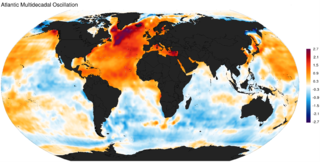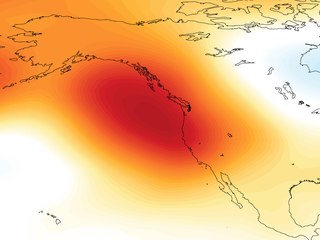Related Research Articles

La Niña is an oceanic and atmospheric phenomenon that is the colder counterpart of El Niño, as part of the broader El Niño–Southern Oscillation (ENSO) climate pattern. The name La Niña originates from Spanish for "the girl", by analogy to El Niño, meaning "the boy". In the past, it was also called an anti-El Niño and El Viejo, meaning "the old man."

El Niño–Southern Oscillation (ENSO) is an irregular periodic variation in winds and sea surface temperatures over the tropical eastern Pacific Ocean, affecting the climate of much of the tropics and subtropics. The warming phase of the sea temperature is known as El Niño and the cooling phase as La Niña. The Southern Oscillation is the accompanying atmospheric component, coupled with the sea temperature change: El Niño is accompanied by high air surface pressure in the tropical western Pacific and La Niña with low air surface pressure there. The two periods last several months each and typically occur every few years with varying intensity per period.

The Antarctic oscillation, also known as the Southern Annular Mode (SAM), is a low-frequency mode of atmospheric variability of the southern hemisphere that is defined as a belt of strong westerly winds or low pressure surrounding Antarctica which moves north or south as its mode of variability.

The Pacific decadal oscillation (PDO) is a robust, recurring pattern of ocean-atmosphere climate variability centered over the mid-latitude Pacific basin. The PDO is detected as warm or cool surface waters in the Pacific Ocean, north of 20°N. Over the past century, the amplitude of this climate pattern has varied irregularly at interannual-to-interdecadal time scales. There is evidence of reversals in the prevailing polarity of the oscillation occurring around 1925, 1947, and 1977; the last two reversals corresponded with dramatic shifts in salmon production regimes in the North Pacific Ocean. This climate pattern also affects coastal sea and continental surface air temperatures from Alaska to California.

The Madden–Julian oscillation (MJO) is the largest element of the intraseasonal variability in the tropical atmosphere. It was discovered in 1971 by Roland Madden and Paul Julian of the American National Center for Atmospheric Research (NCAR). It is a large-scale coupling between atmospheric circulation and tropical deep atmospheric convection. Unlike a standing pattern like the El Niño–Southern Oscillation (ENSO), the Madden–Julian oscillation is a traveling pattern that propagates eastward, at approximately 4 to 8 m/s, through the atmosphere above the warm parts of the Indian and Pacific oceans. This overall circulation pattern manifests itself most clearly as anomalous rainfall.

The Atlantic Multidecadal Oscillation (AMO), also known as Atlantic Multidecadal Variability (AMV), is the theorized variability of the sea surface temperature (SST) of the North Atlantic Ocean on the timescale of several decades.

The Indian Ocean Dipole (IOD), also known as the Indian Niño, is an irregular oscillation of sea surface temperatures in which the western Indian Ocean becomes alternately warmer and then colder than the eastern part of the ocean.

An atmospheric river (AR) is a narrow corridor or filament of concentrated moisture in the atmosphere. Other names for this phenomenon are tropical plume, tropical connection, moisture plume, water vapor surge, and cloud band.

The Monsoon of South Asia is among several geographically distributed global monsoons. It affects the Indian subcontinent, where it is one of the oldest and most anticipated weather phenomena and an economically important pattern every year from June through September, but it is only partly understood and notoriously difficult to predict. Several theories have been proposed to explain the origin, process, strength, variability, distribution, and general vagaries of the monsoon, but understanding and predictability are still evolving.

Climate change in Africa is an increasingly serious threat as Africa is among the most vulnerable continents to the effects of climate change. Some sources even classify Africa as "the most vulnerable continent on Earth". This vulnerability is driven by a range of factors that include weak adaptive capacity, high dependence on ecosystem goods for livelihoods, and less developed agricultural production systems. The risks of climate change on agricultural production, food security, water resources and ecosystem services will likely have increasingly severe consequences on lives and sustainable development prospects in Africa. With high confidence, it was projected by the IPCC in 2007 that in many African countries and regions, agricultural production and food security would probably be severely compromised by climate change and climate variability. Managing this risk requires an integration of mitigation and adaptation strategies in the management of ecosystem goods and services, and the agriculture production systems in Africa.

The "Ridiculously Resilient Ridge", sometimes shortened to "Triple R" or "RRR", is the nickname given to a persistent anticyclone that occurred over the far northeastern Pacific Ocean, contributing to the 2011–2017 California drought. The "Ridiculously Resilient Ridge" nickname was originally coined in December 2013 by Daniel Swain on the Weather West Blog, but has since been used widely in popular media as well as in peer-reviewed scientific literature.
Jessica E. Tierney (born 1982) is an American paleoclimatologist who has worked with geochemical proxies such as marine sediments, mud, and TEX86, to study past climate in East Africa. Her papers have been cited more than 2,500 times; her most cited work is Northern Hemisphere Controls on Tropical Southeast African Climate During the Past 60,000 Years. Tierney is currently an associate professor of geosciences and the Thomas R. Brown Distinguished Chair in Integrative Science at the University of Arizona and faculty affiliate in the University of Arizona School of Geography, Development and Environment Tierney is the first climatologist to win NSF's Alan T Waterman Award (2022) since its inception in 1975.
Pacific Centennial Oscillation is a climate oscillation predicted by some climate models.

Pacific Meridional Mode (PMM) is a climate mode in the North Pacific. In its positive state, it is characterized by the coupling of weaker trade winds in the northeast Pacific Ocean between Hawaii and Baja California with decreased evaporation over the ocean, thus increasing sea surface temperatures (SST); and the reverse during its negative state. This coupling develops during the winter months and spreads southwestward towards the equator and the central and western Pacific during spring, until it reaches the Intertropical Convergence Zone (ITCZ), which tends to shift north in response to a positive PMM.

The effects of climate change on the water cycle are profound and have been described as an intensification or a strengthening of the water cycle. This effect has been observed since at least 1980. One example is the intensification of heavy precipitation events. This has important negative effects on the availability of freshwater resources, as well as other water reservoirs such as oceans, ice sheets, atmosphere and land surface. The water cycle is essential to life on Earth and plays a large role in the global climate and the ocean circulation. The warming of our planet is expected to cause changes in the water cycle for various reasons. For example, warmer atmosphere can contain more water vapor which has effects on evaporation and rainfall.
Rodwell–Hoskins mechanism is a hypothesis about a climatic teleconnection between the Indian/Asian summer monsoon and the climate of the Mediterranean. It stipulates that ascending air in the monsoon region induces atmospheric circulation features named Rossby waves that expand westward and interact with the mean westerly winds of the midlatitudes, eventually inducing descent of the air. Descending air warms and its humidity decreases, thus resulting in a drier climate during the summer months. The interaction of this atmospheric flow with the topography such as the Atlas and Zagros mountains further modifies the effect.

Effects of the El Niño–Southern Oscillation in Australia is present across most of Australia, particularly the north and the east, and is one of the main climate drivers of the country. Associated with seasonal abnormality in many areas in the world, Australia is one of the continents most affected and experiences extensive droughts alongside considerable wet periods that cause major floods. There exist three phases — El Niño, La Niña, and Neutral, which help to account for the different states of ENSO. Since 1900, there have been 27 El Niño and 18 La Niña events in Australia. The events usually last for 9 to 12 months, but some can persist for two years, though the ENSO cycle generally operates over a time period from one to eight years.
Lisa M. Beal is a professor at the University of Miami known for her work on the Agulhas Current. She is the editor-in-chief of the Journal of Geophysical Research: Oceans.
Lisa Victoria Alexander is an international expert on heatwaves. She received the Dorothy Hill Medal for her research on climate extremes, the frequency and intensity of heatwaves, and has provided evidence that the frequency and intensity of heatwaves will be influenced by the quantity of anthropogenic greenhouse gas emissions, in particular carbon dioxide. She was a contributing author to the Intergovernmental Panel on Climate Change (IPCC) reports, including the fifth assessment report.
Andréa Sardinha Taschetto or A. S. Taschetto; Andréa Taschetto is a climate change scientist at the University of New South Wales, and winner of the Dorothy Hill award. She was awarded an Australian Research Council Future Fellowship in 2016. Her research has contributed to improved understanding of the role of oceans, on climate variability at regional scales, and from seasonal to mulit-decade timescales. This research also has assisted with future climate projections.
References
- 1 2 3 4 5 6 LaCapra, Véronique (22 May 2017). "Extreme Climate; A Conversation with WHOI's Caroline Ummenhofer". OceanUS Magazine. Archived from the original on 2017-06-04. Retrieved September 12, 2019.
- 1 2 3 Schmitt, Raymond W. (2018). "Caroline C. Ummenhofer". AGU100. Archived from the original on 2021-06-13. Retrieved 2019-09-13.
- 1 2 3 4 5 6 "Alexander von Humboldt Foundation Honors Two WHOI Scientists". Woods Hole Oceanographic Institution. December 12, 2014. Archived from the original on 2019-04-26. Retrieved 2019-09-13.
- ↑ Ummenhofer, Caroline C.; England, Matthew H. (2007). "Interannual Extremes in New Zealand Precipitation Linked to Modes of Southern Hemisphere Climate Variability". Journal of Climate. 20 (21): 5418–5440. Bibcode:2007JCli...20.5418U. doi: 10.1175/2007jcli1430.1 . ISSN 0894-8755.
- 1 2 3 4 5 Times, Doug Fraser Cape Cod. "Centuries-old whaling logs yield clues for modern-day climate studies". southcoasttoday.com. Retrieved 2019-09-14.
- ↑ Ferreira, Becky (2019-06-28). "Centuries-Old Sea Captain Diaries Are Confirming Modern Climate Science". Vice. Retrieved 2019-09-14.
- 1 2 3 Lubofsky, Evan (June 26, 2019). "Mining Climate Clues from our Whaling Past". Woods Hole Oceanographic Institution. Archived from the original on 2019-07-01. Retrieved 2019-09-14.
- 1 2 3 4 5 Ummenhofer, Caroline C.; England, Matthew H.; McIntosh, Peter C.; Meyers, Gary A.; Pook, Michael J.; Risbey, James S.; Gupta, Alexander Sen; Taschetto, Andréa S. (2009). "What causes southeast Australia's worst droughts?". Geophysical Research Letters. 36 (4): L04706. Bibcode:2009GeoRL..36.4706U. doi: 10.1029/2008GL036801 . ISSN 1944-8007.
- ↑ Hahn, L.; Ummenhofer, C. C.; Kwon, Y.-O. (2018-09-16). "North Atlantic Natural Variability Modulates Emergence of Widespread Greenland Melt in a Warming Climate" (PDF). Geophysical Research Letters. 45 (17): 9171–9178. Bibcode:2018GeoRL..45.9171H. doi: 10.1029/2018GL079682 . hdl:1912/10638.
- ↑ Lippsett, Lonny (May 1, 2017). "To Forecast Rain, Look to the Ocean". Woods Hole Oceanographic Institution. Archived from the original on 2020-07-29. Retrieved 2019-09-14.